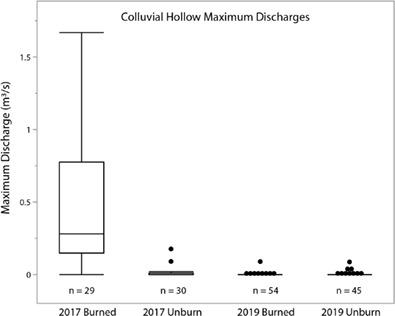当前位置:
X-MOL 学术
›
Hydrol. Process.
›
论文详情
Our official English website, www.x-mol.net, welcomes your
feedback! (Note: you will need to create a separate account there.)
Increased colluvial hollow discharge and subsequent recovery after a low intensity wildfire in the Blue Ridge Mountains, USA
Hydrological Processes ( IF 2.8 ) Pub Date : 2020-11-13 , DOI: 10.1002/hyp.13971 Liam C. Stiefel 1 , Susannah C. Cooley 1 , Bradley G. Johnson 1
Hydrological Processes ( IF 2.8 ) Pub Date : 2020-11-13 , DOI: 10.1002/hyp.13971 Liam C. Stiefel 1 , Susannah C. Cooley 1 , Bradley G. Johnson 1
Affiliation

|
Wildfires in mountainous regions have been documented to enhance water repellent soils which can increase runoff, erosion, and sedimentation during subsequent rain events. However, the extent of soil hydrophobicity and water repellency varies significantly with burn severity and between ecosystems, and the southern Appalachians remain an understudied region. Here we examine the impact of the low severity Chestnut Knob Fire, which occurred in the fall 2016, on soil properties and runoff in South Mountains State Park. To examine these impacts, we installed crest‐stage gauges in burned (n = 10) and unburned (n = 8) colluvial hollows to compare peak runoff. Results from the 2017 field season indicated that burned locations produced significantly higher peak discharges than unburned sites. From July 2019 to January 2020, we repeated the experiment and found that burned areas produced runoff comparable to unburned areas. Examination of soil profiles during the summer of 2017 found high variability in hydrophobicity in both the burned (n = 10) and unburned (n = 2) soils. Further, we found that burned soils had significantly deflated organic surface horizons compared with unburned soils. We interpret the differences in runoff in 2017 to be the result of a combination of increased hydrophobicity and decreased soil moisture storage capacity in organic rich surface soils. While the recovery we observed here was relatively fast, it is important to understand that increased runoff immediately after a fire likely increases the chances of sediment mobilization and debris flow occurrence.
中文翻译:

在美国蓝岭山脉发生低强度野火后,河流中空洞排放增加,随后恢复
山区的野火已被证明可以增强憎水土壤,从而在随后的降雨事件中增加径流,侵蚀和沉积。但是,土壤的疏水性和疏水性的程度随烧伤程度和生态系统的不同而有很大的不同,南部的阿巴拉契亚山脉仍然是一个未被充分研究的地区。在这里,我们研究了2016年秋季发生的低强度板栗旋钮火对南山州立公园的土壤特性和径流的影响。为了检查这些影响,我们在燃烧(n = 10)和未燃烧(n= 8)凹坑比较峰径流量。2017年田野季节的结果表明,被烧毁的地点产生的峰值排放量明显高于未烧毁的地点。从2019年7月到2020年1月,我们重复了该实验,发现燃烧区产生的径流与未燃烧区相当。的2017年夏季的土壤剖面检查发现在疏水性高的可变性在两个燃烧(Ñ = 10)和未燃烧的(Ñ= 2)土壤。此外,我们发现与未燃烧的土壤相比,燃烧的土壤具有显着收缩的有机表面层。我们将2017年径流的差异解释为疏水性增加和有机富集表层土壤中土壤水分存储能力下降的综合结果。尽管我们在此处观察到的恢复速度相对较快,但重要的是要了解火灾后径流增加可能会增加沉积物动员和泥石流发生的机会。
更新日期:2021-01-13
中文翻译:

在美国蓝岭山脉发生低强度野火后,河流中空洞排放增加,随后恢复
山区的野火已被证明可以增强憎水土壤,从而在随后的降雨事件中增加径流,侵蚀和沉积。但是,土壤的疏水性和疏水性的程度随烧伤程度和生态系统的不同而有很大的不同,南部的阿巴拉契亚山脉仍然是一个未被充分研究的地区。在这里,我们研究了2016年秋季发生的低强度板栗旋钮火对南山州立公园的土壤特性和径流的影响。为了检查这些影响,我们在燃烧(n = 10)和未燃烧(n= 8)凹坑比较峰径流量。2017年田野季节的结果表明,被烧毁的地点产生的峰值排放量明显高于未烧毁的地点。从2019年7月到2020年1月,我们重复了该实验,发现燃烧区产生的径流与未燃烧区相当。的2017年夏季的土壤剖面检查发现在疏水性高的可变性在两个燃烧(Ñ = 10)和未燃烧的(Ñ= 2)土壤。此外,我们发现与未燃烧的土壤相比,燃烧的土壤具有显着收缩的有机表面层。我们将2017年径流的差异解释为疏水性增加和有机富集表层土壤中土壤水分存储能力下降的综合结果。尽管我们在此处观察到的恢复速度相对较快,但重要的是要了解火灾后径流增加可能会增加沉积物动员和泥石流发生的机会。











































 京公网安备 11010802027423号
京公网安备 11010802027423号